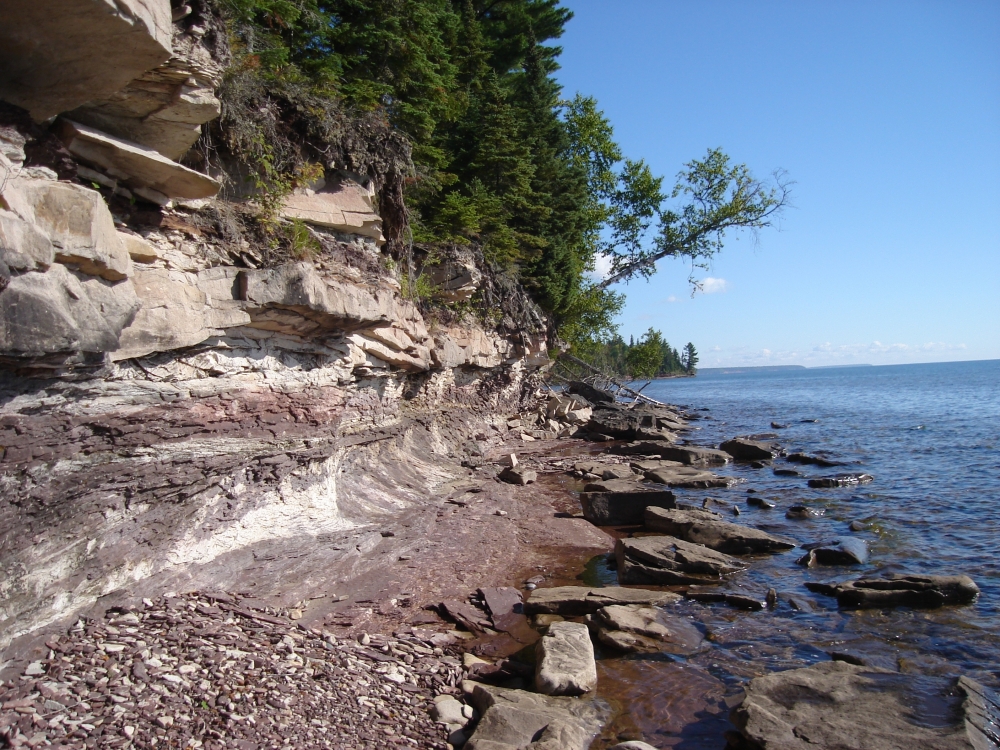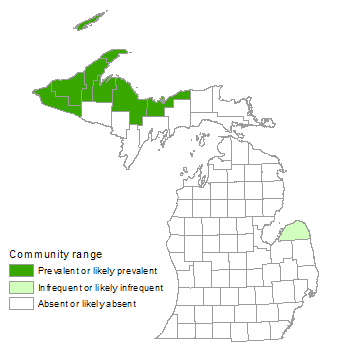Sandstone Lakeshore Cliff
Overview
Sandstone lakeshore cliff consists of vertical or near-vertical exposures of bedrock with sparse coverage of vascular plants, lichens, mosses, and liverworts. The community occurs primarily in the central and western Upper Peninsula along Lake Superior but also is found along a short stretch of shore along Lake Huron in the thumb region. Sandstone lakeshore cliffs range from 2 to 65 m (6 to 200 ft) high and are characterized by high site moisture due to the proximity to the Great Lakes and a stressed and unstable environment because of severe waves, wind, and winter ice.
Rank
Global Rank: G3 - Vulnerable
State Rank: S2 - Imperiled

Landscape Context
Sandstone cliffs occur primarily along the shores of Lake Superior as part of the Copper Harbor Conglomerate, Jacobsville Sandstone, and Nonesuch and Freda Formations, stretching from the Wisconsin-Michigan boundary in the west to east of Munising in Pictured Rocks National Lakeshore. There are over 24 km (15 miles) of cliff in the Porcupine Mountains, 10 km (6 miles) near Point Abbaye, 11 km (7 miles) in the Huron Mountain Club, and over 29 km (18 miles) at the Pictured Rocks National Lakeshore and Grand Island. In all, about 128 km (80 miles) of sandstone lakeshore cliff occur along Lake Superior, and another 0.5 miles of cliff composed of Marshall Sandstone occurs at Pointe Aux Barques on southern Lake Huron. Cliffs range from 2 to 65 m (6 to 200 ft) high, with the highest cliffs at the Pictured Rocks National Lakeshore. Similar sandstone cliffs occur along the Wisconsin shoreline of Lake Superior. In Michigan, sandstone lakeshore cliff is typically bordered along its inland margin by boreal forest, dry-mesic northern forest, mesic northern forest, and occasionally by forested wetlands. Along the shoreline, sandstone lakeshore cliffs are interspersed with areas of sandstone bedrock lakeshore, sandstone cobble shore, volcanic lakeshore cliff, volcanic bedrock lakeshore, volcanic cobble shore, granite bedrock lakeshore, granite bedrock cliff, and sand and gravel beach.
Soils
There is almost no soil development on the cliffs except for shallow organic soil development along the narrow cliff summit and ledges, in crevices in the cliff face, and at the base of the cliff where sand particles, decaying roots, and plant debris accumulate. The breakdown of sandstone and plant matter results in an acidic, sandy, organic-rich soil.
Natural Processes
The vertical structure of cliffs causes constant erosion and restricts soil development to the cliff edge, ledges, crevices, and the base of the cliff where organic matter and sandy particles can accumulate. The thin soils and direct exposure to wind, ice, and sun produce desiccating conditions that limit plant growth. However, cliff aspect and local seepages result in a variability of site moisture conditions. North- and east-facing cliffs are typically moister than south- and west-facing cliffs because of reduced wind and reduced direct exposure to the sun. Moisture can be locally present on cliff faces due to local groundwater seepages along the cliff face and surface flow across the cliff during rain events or snow melt. In addition, fog occurs regularly on the coast, fostering the growth of moss and lichen. Windthrown trees are common along the tops of cliffs due to strong lake winds and shallow soils. Windblown trees at the base of the cliff provide localized areas for soil accumulation. Sandstone cliff faces regularly break free, forming blocky talus at the base of many of the sandstone cliffs and exposing fresh, bare rock substrates. Cliff faces are scoured by ice and waves, further increasing rates of erosion.
Vegetation
While mosses, lichens, and liverworts can be common on the exposed cliff face, vascular plant cover is sparse, being generally restricted to the flat, exposed bedrock at the upper edge of the cliff (i.e., lip), ledges, crevices in the cliff face, and along the cliff base if a ledge of talus, cobble, sand, or bedrock is present between the cliff and the open water. Mosses, lichens, and liverworts are dominant in groundwater seepage areas along the cliff face, where streams pass over the cliff face, and where cliff faces overhang the water. Common herbaceous species associated with sandstone lakeshore cliff include fragile fern (Cystopteris fragilis), northern beech fern (Phegopteris connectilis), lady fern (Athyrium filix-femina), spinulose woodfern (Dryopteris carthusiana), hair grass (Deschampsia cespitosa), yarrow (Achillea millefolium), fireweed (Epilobium angustifolium), wild strawberry (Fragaria virginiana), harebell (Campanula rotundifolia), common horsetail (Equisetum arvense), grass-leaved goldenrod (Euthamia graminifolia), hairy hawkweed (Hieracium gronovii), marsh violet (Viola cucullata), marsh pea (Lathyrus palustris), jewelweed (Impatiens capensis), northern bugleweed (Lycopus uniflorus), and two invasive plants, pearlwort (Sagina procumbens) and Canada bluegrass (Poa compressa). Common shrubs include ninebark (Physocarpus opulifolius), dwarf raspberry (Rubus pubescens), wild red raspberry (R. strigosus), mountain alder (Alnus viridis), bush honeysuckle (Diervilla lonicera), cherries (Prunus spp.), serviceberries (Amelanchier spp.), and willows (Salix spp.). Scattered and stunted trees are restricted to ledges and crevices and include paper birch (Betula papyrifera), white spruce (Picea glauca), northern white-cedar (Thuja occidentalis), balsam fir (Abies balsamea), and quaking aspen (Populus tremuloides). Trees occurring at the top of the cliff include sugar maple (Acer saccharum), paper birch, white spruce, balsam poplar (Populus balsamifera), white pine (Pinus strobus), northern white-cedar, and hemlock (Tsuga canadensis).
Many of the Jacobsville Sandstone sites have blocky talus at the base of the cliffs, while talus is absent on most Freda Sandstone sites. The talus supports almost no vegetation, probably due to frequent inundation and severe storm waves. The cliff face is largely unvegetated, except within cracks, on ledges, and where there are seepages or small streams crossing the rock surface. In these moist areas mosses, lichens, and grasses often form thick vegetation beds. The density and diversity of the vegetation of sandstone lakeshore cliffs tend to be greater along lower escarpments. The tops of the cliffs are typically boreal forest but can include dry-mesic northern forest, mesic northern forest, and less frequently forested wetland.
For information about plant species, visit the Michigan Flora website.
Plant Lists
Graminoids
- tufted hair grass (Deschampsia cespitosa)
Forbs
- yarrow (Achillea millefolium)
- harebell (Campanula rotundifolia)
- fireweed (Chamerion angustifolium)
- grass-leaved goldenrod (Euthamia graminifolia)
- wild strawberry (Fragaria virginiana)
- hairy hawkweed (Hieracium gronovii)
- jewelweed (Impatiens capensis)
- marsh pea (Lathyrus palustris)
- Kalm’s lobelia (Lobelia kalmii)
- northern bugle weed (Lycopus uniflorus)
- bird’s-eye primrose (Primula mistassinica)
- three-toothed cinquefoil (Sibbaldiopsis tridentata)
- marsh violet (Viola cucullata)
Ferns
- lady fern (Athyrium filix-femina)
- fragile fern (Cystopteris fragilis)
- spinulose woodfern (Dryopteris carthusiana)
- northern beech fern (Phegopteris connectilis)
Fern Allies
- common horsetail (Equisetum arvense)
Shrubs
- mountain alder (Alnus viridis)
- serviceberries (Amelanchier spp.)
- red-osier dogwood (Cornus sericea)
- bush honeysuckle (Diervilla lonicera)
- ninebark (Physocarpus opulifolius)
- choke cherry (Prunus virginiana)
- dwarf raspberry (Rubus pubescens)
- wild red raspberry (Rubus strigosus)
- willows (Salix bebbiana, S. discolor, and others)
Trees
- balsam fir (Abies balsamea)
- sugar maple (Acer saccharum)
- paper birch (Betula papyrifera)
- American beech (Fagus grandifolia)
- white spruce (Picea glauca)
- white pine (Pinus strobus)
- balsam poplar (Populus balsamifera)
- quaking aspen (Populus tremuloides)
- black cherry (Prunus serotina)
- northern white-cedar (Thuja occidentalis)
- hemlock (Tsuga canadensis)
Noteworthy Animals
Cliffs provide nesting habitat for raptors and common ravens (Corvus corax).
Rare Plants
- Carex atratiformis (sedge, state threatened)
- Cryptogramma stelleri (slender rock brake, state special concern)
- Empetrum nigrum (crowberry, state threatened)
- Gymnocarpium robertianum (northern beech fern, state threatened)
- Pinguicula vulgaris (butterwort, state special concern)
- Senecio indecorus (rayless mountain ragwort, state threatened)
- Trisetum spicatum (downy oatgrass, state special concern)
- Vaccinium cespitosum (dwarf bilberry, state threatened)
Rare Animals
- Falco columbarius (merlin, state threatened)
- Falco peregrinus (peregrine falcon, state endangered)
- Haliaeetus leucocephalus (bald eagle, state threatened)
Biodiversity Management Considerations
Threats to lakeshore cliffs include shoreline development, logging of adjacent uplands and associated soil erosion, excessive foot traffic along the upper edge, and invasive plants. The thin soils and unstable environment make soil development and plant reestablishment slow, highlighting the importance of minimizing logging and excessive trampling along the upper edge of cliffs. Maintaining a mature, unfragmented forested buffer around sandstone lakeshore cliffs may help limit the local seed source for invasive species distributed by wind or birds. Some of the invasive plants that may threaten the biodiversity of sandstone lakeshore cliffs include spotted knapweed (Centaurea stoebe), ox-eye daisy (Leucanthemum vulgare), sheep sorrel (Rumex acetosella), hawkweeds (Hieracium spp.), Kentucky bluegrass (Poa pratensis), Canada bluegrass, and pearlwort. Monitoring and control efforts to detect and remove these and other invasive species will help maintain the ecological integrity of sandstone lakeshore cliff and surrounding natural communities.
Variation
The sandstone bedrock along Lake Superior varies significantly in texture and erosion resistance, which influence vegetative composition and structure. Some of the sandstone cliffs grade into much finer siltstone.
Similar Natural Communities
Volcanic lakeshore cliff, granite lakeshore cliff, limestone lakeshore cliff, granite cliff, limestone cliff, sandstone cliff, volcanic cliff, granite bedrock glade, volcanic bedrock glade, sandstone bedrock lakeshore, and sandstone cobble shore.
Places to Visit
- Little Presque Isle, Gwinn State Forest Management Unit, Marquette Co.
- Pictured Rocks, Pictured Rocks National Lakeshore, Alger Co.
- Point Abbaye, Baraga State Forest Management Unit, Baraga Co.
- Rabbit Bay, Baraga State Forest Management Unit, Houghton Co.
Relevant Literature
- Albert, D.A., P. Comer, D. Cuthrell, D. Hyde, W. MacKinnon, M. Penskar, and M. Rabe. 1997. The Great Lakes bedrock lakeshores of Michigan. Michigan Natural Features Inventory, Lansing, MI. 218 pp.
- Bornhorst, T.J., and W.I. Rose. 1994. Self-guided geological field trip to the Keweenaw Peninsula, Michigan. Proceedings of the Institute on Lake Superior Geology. Volume 40, Part 2. 185 pp.
- Dorr, J.A., Jr., and D.F. Eschman. 1970. Geology of Michigan. University of Michigan Press, Ann Arbor, MI. 470 pp.
- Faber-Langendoen, D., ed. 2001. Plant communities of the Midwest: Classification in an ecological context. Association for Biodiversity Information, Arlington, VA. 61 pp. + appendix (705 pp.).
- LaBerge, G.L. 1994. Geology of the Lake Superior region. Geoscience Press, Phoenix, AZ. 313 pp.
- Reed, R.C., and J. Daniels. 1987. Bedrock geology of northern Michigan. State of Michigan Department of Natural Resources. Map: 1: 500,000.
For a full list of references used to create this description, please refer to the natural community abstract for Sandstone Lakeshore Cliff.
More Information
Citation
Cohen, J.G., M.A. Kost, B.S. Slaughter, D.A. Albert, J.M. Lincoln, A.P. Kortenhoven, C.M. Wilton, H.D. Enander, and K.M. Korroch. 2020. Michigan Natural Community Classification [web application]. Michigan Natural Features Inventory, Michigan State University Extension, Lansing, Michigan. Available https://mnfi.anr.msu.edu/communities/classification. (Accessed: December 27, 2025).
Kost, M.A., D.A. Albert, J.G. Cohen, B.S. Slaughter, R.K. Schillo, C.R. Weber, and K.A. Chapman. 2007. Natural Communities of Michigan: Classification and Description. Michigan Natural Features Inventory, Report No. 2007-21, Lansing, MI.


